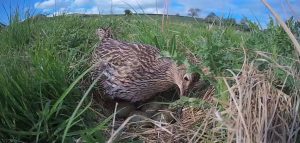Blog by Curlew Country Officer, Amber Bicheno
Curlew Cam has given all of us at Curlew Country, as well as members of the public from all over the world, a wonderful glimpse into the nesting habits of this wonderful wader. They are such secretive birds and this keyhole look offers a chance for learning and discovery.

In 2017 Curlew Country obtained the first UK licence to take eggs from the nest and incubate them to try and improve breeding success. That year all eggs were returned to natural nests at pipping stage and hatched chicks which parents reared naturally. All the chicks were subsequently lost, presumed predated. In 2018 and 2019 we committed ourselves to head-starting as many chicks as we could (and many more than the 6 chicks successfully reared and released that had accidentally resulted from the egg to nest pipping trial the year in 2017).

When in the wild, parent birds seem to instinctively know the ideal conditions and requirements for their eggs. You will see the adults turning them with their bill and jostling the eggs as they shuffle in the nest at seemingly irregular intervals. Turning the eggs is very important, especially during early incubation, as it stops the embryo sticking to one spot of the membrane inside the egg, allowing for proper development. Temperature is also vital to get right for successful hatching. As they nestle onto the eggs, their feathers act as insulation, keeping the eggs warm in the cold, but also protecting them from excessive heat. During head-starting, we try hard to mimic these settings in order to get the eggs to hatch, however it is impossible to exactly replicate the unique conditions provided by the parent birds in the wild. What we can ensure through head-starting, is that most of the resulting chicks will go on to fledge successfully, being protected from predators and risks from farming operations.

In 2018 after the ‘beast from the east’ and cold weather into April, suddenly we had sunny warm weather like it is now. It made our work much easier, not so much at incubation stage of course when we fussed around with basic incubators, trying not to let them overheat in the only room we had available, but for the ongoing work outside. 2019 seemed to go almost the opposite direction in terms of weather, with torrential rain assailing us every time we set about constructing the large outdoor pens, and desperately trying to keep the animal houses with young chicks in dry. For artificial incubation to have the best chance of success, it is not just the temperature of the incubators themselves that must be carefully monitored, but also the room in which they are kept. If this external temperature fluctuates too much, it can affect the temperature inside the incubators, affecting their ability to keep up. In the wild, the adult birds can control the temperature using their brood patch and through time away from the nest.

The turning of the eggs must also be mimicked in artificial incubation, to ensure proper development of the embryo. In most cases this is done automatically through the incubator itself, although manual turning can also be done. In 2018, it caused us some minor panic when we realised that the automatic turning was not working effectively, due to the size of the curlew eggs. We compensated for this by adding in manual turns, and in 2019 through our partnership with the Wildfowl and Wetlands Trust (WWT) we upgraded our incubators to ones that could accommodate their differing size and shape!

To assess how the eggs are getting on when head-starting, we can use candling. This technique involves shining a powerful light at one end of the egg and assessing the development of the embryo inside. IT can be a great way to ensure the eggs are on track, spot when they are close to hatching, and most importantly spot any eggs which might have died or are not developing properly. This very useful technique, combined with regular weighing of the eggs, allows us to pinpoint any eggs that might need extra attention during hatching. Obviously in wild nests, we do not have this luxury. It is all down to the adults, and the instincts of the chicks to push themselves out of the egg. In some cases, in can take up to 3 days for the chicks to fully hatch, which can make it even more tense on Curlew Cam for us viewing! So begins the nervous watching and waiting, at time of writing two chicks have emerged from the eggs, with 2 still to go. Once they have all hatched, they will only remain in the nest for a couple of days at most, then setting off to find food amongst the nearby fields.
The Curlew Country Team and I have fingers crossed for these little ones, as this is just the start of a difficult journey for them.


